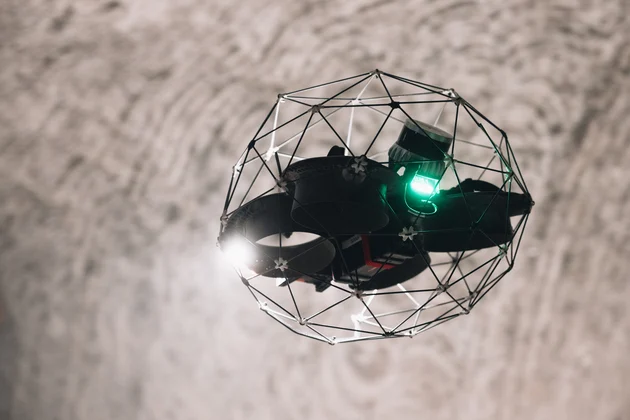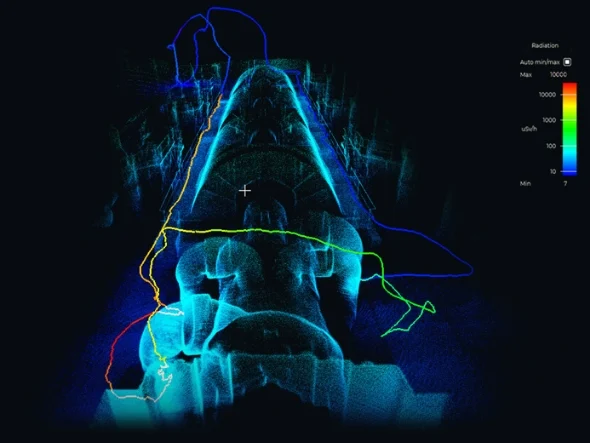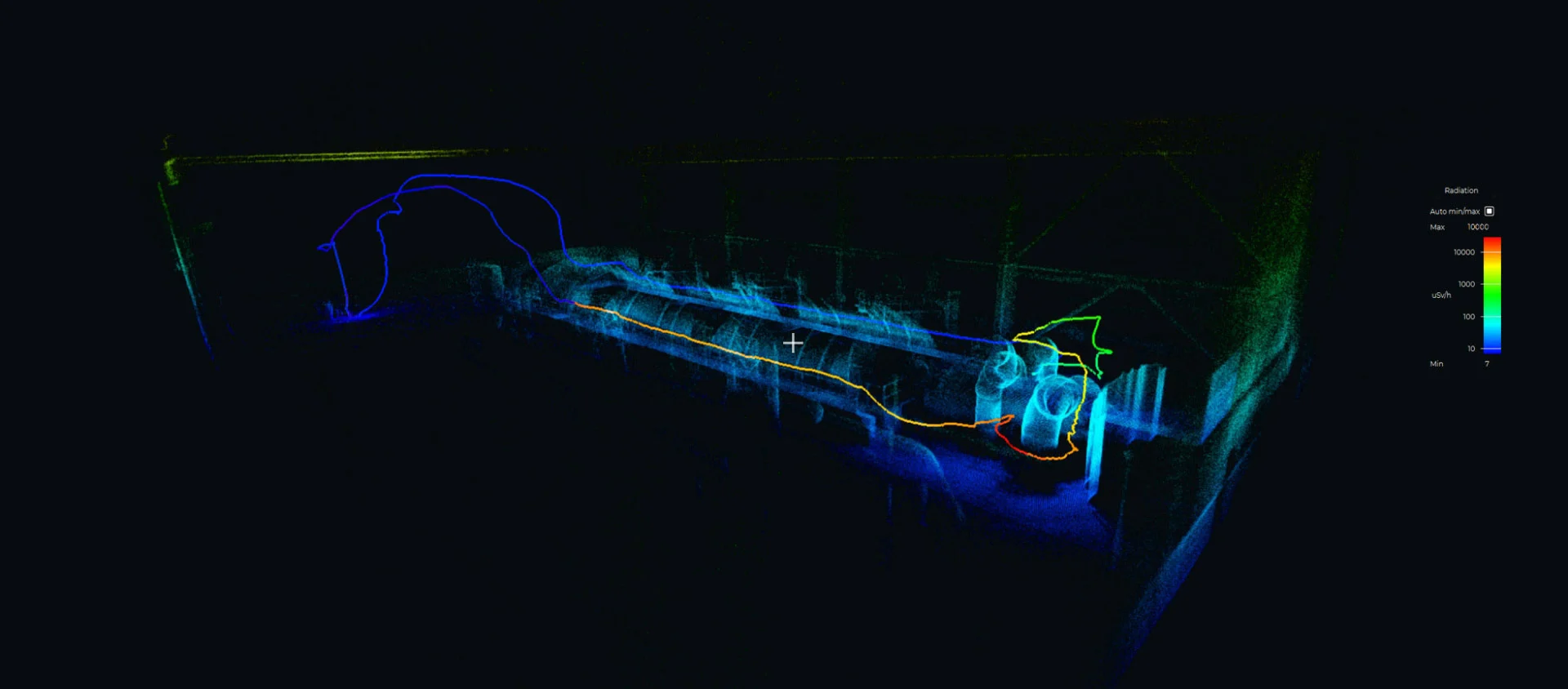How you can use the Elios 3 RAD
Key Benefits at a Glance
|
Accessibility The Elios 3 RAD enables the detection of contamination, allowing for the creation of detailed radiation heat maps without putting personnel in potentially hazardous environments. |
Data Depth Equipped with the RAD payload, drone operators can collect comprehensive data to generate a "heat map" of potentially radioactive or contaminated areas within confined spaces. |
Â
|
Operational Insights The Elios 3 RAD serves as both a scout and inspector, offering actionable insights that can enhance site management and operational planning. |
Enhanced Safety This workflow empowers safer operations by leveraging the RAD payload's data collection capabilities without exposing personnel to risks. |
Introducing the Elios 3 RAD
The Elios 3 RAD combines our modular Elios 3 drone with a radiation detection sensor payload, enabling advanced drone inspection workflows. Launched in 2022, the Elios 3 is specifically designed for confined space inspections, whether inside a pipe or exploring an unknown cave. Its protective cage and collision-resistant flight algorithms empower confident navigation in challenging environments. This durability stems from its innovative design, which shields propellers with the cage and uses specialized flight and motor controls to stabilize the drone post-collision. These features make the Elios 3 ideal for beyond-line-of-sight operations or enclosed spaces where human entry is too risky.

The Elios 3 RAD enhances safety and efficiency in radiation detection operations.
In 2023, the Elios 3's modular payload lineup expanded to include the RAD sensor - RAD standing for radiation detection. Developed by Mirion Technologies, experts in creating tools for detecting and measuring radioactive materials, this sensor is a game-changer. With the Elios 3 RAD, you can detect and measure radioactive material ranging from nuclear power plant components to old, contaminated assets involved in decommissioning projects.
The advantages of using a drone for nuclear inspections are manifold:
- Improved Safety
- A drone can scout environments ahead of personnel to assess radiation levels and decide whether it's safe for humans to enter or if additional precautions are necessary. This preliminary survey aids operation planning.
- Real-time alerts and data collection empower rapid decision-making and response to changes in radiation levels.
- Superior Data Collection
- The Elios 3 RAD can inspect contaminated areas and gather detailed data on radiation levels, providing insights unavailable with remote sensors alone.
- The Elios 3 RAD collects visual, volumetric, and radiological data, creating inputs for both 3D modeling and radiological surveys using drones.
- Enhanced Access
- Engineers can now visualize more than ever before. The Elios 3 RAD can inspect assets whether they're in a room or high above ground, ensuring comprehensive data collection for previously hard-to-access areas.
- Remote control allows the Elios 3 to enter spaces without people. It can inspect the insides of assets like pipes—provided there's enough clearance (50x50cm to enter and 60x60cm to inspect).
- Â
The sensor used in the Elios 3 RAD is the RDS32-WR, manufactured by Mirion Technologies. Renowned globally for their radiological survey and radiation detection solutions, they bring unparalleled expertise to data collection, making them the perfect partner for Elios 3 inspections.
How Can You Use the Elios 3 RAD for Operations Involving Radioactive Materials?
The Elios 3 RAD has applications spanning nuclear power plant inspections to contributions toward nuclear decommissioning efforts. Here are three key scenarios demonstrating its potential:
Managing Radioactive Waste Storage
Nuclear waste management is a complex challenge due to the long-term radioactivity of these materials. Sometimes, this waste is stored in sealed-off areas, but other times, it's kept in carefully constructed cement-lined barrels. These barrels are housed in specialized storage facilities that undergo regular monitoring to ensure containment integrity. A drone inspection with the Elios 3 RAD in such an environment is highly effective. The Elios 3 RAD can periodically fly inside warehouses to monitor radiation levels. In environments like this, the "ALARA" principle applies—radiation levels should be as low as reasonably achievable. This necessitates implementing every feasible measure to minimize human exposure to radiation.

This image shows a turbine deck scanned with the Elios 3 RAD, highlighting the drone's ability to access the entire asset easily.
With the Elios 3 RAD, a database of inspection readings can be built over time to track changes in radiation levels. This historical data helps waste management teams anticipate maintenance needs or respond swiftly if a storage area becomes compromised. In such cases, the Elios 3 RAD offers extensive data coverage with minimal human exposure, reducing risks significantly.
Scanning Sites for Radioactive Contamination, Including Power Plants
A basic drone inspection of a nuclear power plant can save up to $500,000. Safety is paramount in these environments, often housing radioactive materials. With the Elios 3 RAD, pre-scans of areas can be conducted before personnel enter to evaluate radiation levels and perform visual inspections.
For instance, suppose there’s a suspected breach in a pipe carrying potentially radioactive waste at a nuclear power plant. The Elios 3 RAD could investigate the area, creating a radiation heat map to pinpoint the breach location and radiation intensity. If exposed to radiation, the drone can remain in the area as long as its mechanics remain unaffected, requiring only battery changes and data collection during human interaction. This approach ensures safe drone usage in contaminated zones without spreading contamination beyond the area. Such a closed operational cycle delivers valuable situational data while adhering to stringent safety protocols.
Similar case studies might occur at nuclear power plants or decommissioning sites. The Elios 3 RAD represents a revolutionary opportunity to improve safety while boosting site awareness through enhanced data collection from hard-to-reach locations.
Underground Radioactive Material Storage
Another example involves underground storage facilities for direct disposal of nuclear waste. Projects of this kind exist worldwide, aiming to reduce human contact with radioactive materials by burying them deep in underground repositories. Some of these spaces are permanently sealed, while others are frequently monitored, such as this U.S. Department of Energy site. Monitoring is crucial because storage areas may require maintenance, like repairing concrete walls.
Â

This scan of a turbine deck with the Elios 3 RAD reveals distinct variations in radiation levels across the area.
An Elios 3 RAD could explore these confined spaces, conducting both visual inspections and radiation surveys. This would enable management teams to plan maintenance efficiently and reduce on-site time by preparing strategies based on 3D models created with the Elios 3's visual inspection. Additionally, the RAD survey ensures that radiation levels are closely monitored to confirm waste stability and detect any leaks.
Radioactive or nuclear waste encompasses anything from heavy water and spent uranium fuel rods at nuclear power plants to more diverse items like old medical equipment. Careful management of this material becomes easier with the Elios 3 RAD.
The Future of Drone Inspections in Nuclear Environments
Implementing drones for radiation management marks a significant leap forward in enhancing safety for an increasingly complex industry. The Elios 3 drone with the RAD payload holds promise for both nuclear power plants and waste management—where waste remains radioactive for thousands of years.
As several European countries, including Switzerland and Germany, phase out their nuclear energy plants, the challenge of managing leftover waste and materials will intensify while the need for inspecting current plants persists. Modern technology must evolve to meet these challenges, and the Elios 3 RAD offers a novel way to gather data from previously unreachable areas while boosting safety. This represents an exciting advancement in the power generation and waste management sectors.
Learn more about the Elios 3 RAD today.
Valve Body Repair Kit ,Valve Repair,Valve Body Repair Package,Valve Body Repair Kits
HONG KONG CRS INTERNATIONAL TRADING COMPANY LIMITED , https://www.crstrans.com